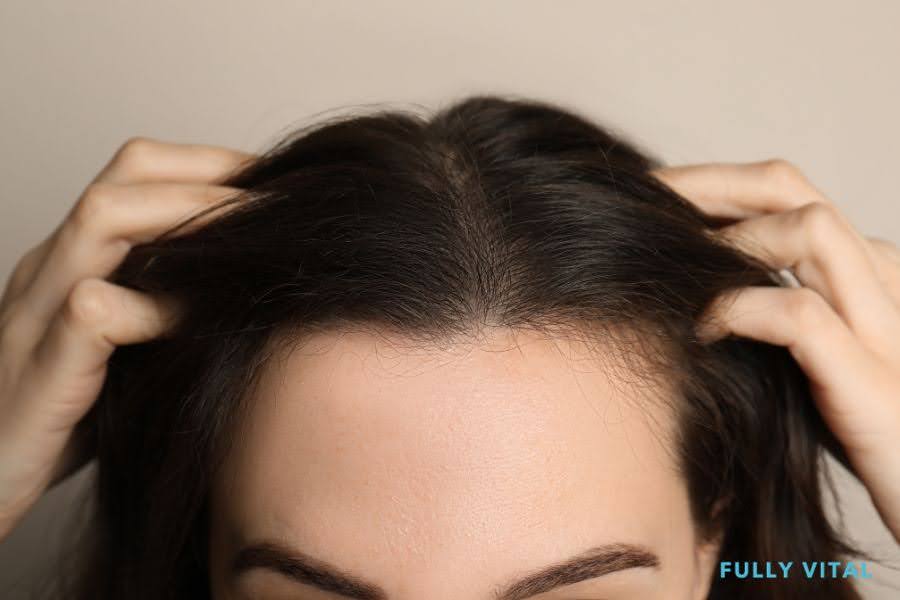
The Ultimate Guide to Fixing a Bad Hairline
Your hairline acts as a natural frame for your face, and it plays a pivotal role in your overall appearance.
When this frame starts to shift unfavorably, it can be distressing, sometimes affecting self-esteem.
Addressing issues with your hairline is more than a cosmetic concern; it reflects your dedication to personal care and an awareness of your health.
A bad hairline may signal underlying health issues or the need for a lifestyle change.
In this comprehensive guide, we'll arm you with strategies and knowledge to understand and tackle a receding or problematic hairline.
From identifying early signs to exploring treatment options, this guide is your ally in the quest for hair wellness.
Navigating a changing hairline?
Explore FullyVital's solutions designed to support hair growth and learn how they can integrate with your daily routine for optimal scalp health.

I LOVE MY HAIR NOW
FullyVital hair serum and hair vitamins made tremendous improvements in my hair. I truly love my hair now.
Shop Hair ProductsUnderstanding Hairlines
Everyone's hairline is unique, and recognizing the type you have is integral to understanding normal changes versus signs of a bad hairline.
Hairlines come in a variety of shapes – some are naturally straight, while others might have a distinctive 'M' shape or widow's peak.
Identifying your hairline type helps you track any changes and can be valuable when discussing concerns with a professional.
Accepting your natural hairline as the standard for your appearance is the first step in detecting anomalies.
Being familiar with different hairline types can also aid in choosing the right treatments and styles that complement your natural look.
What Causes a Bad Hairline?
The dreaded 'bad hairline' can stem from several causes, such as genetics, hormonal imbalances, or lifestyle factors.
Genetic predisposition plays a significant role; if your family has a history of hairline issues, you might be more prone to experiencing them.
Hormonal changes such as those in thyroid disorders or during life events like pregnancy can affect hair growth patterns.
External factors like stress, poor nutrition, and harsh styling practices can also contribute to the deterioration of your hairline.
Understanding these factors is critical for taking preventative measures or seeking appropriate treatments.
Early Signs of a Bad Hairline
Recognizing the Warning Signals
Noticing the first signs of hairline changes early can make a substantial difference in managing the situation effectively.
Keep an eye out for increased shedding, thinning at the temples, or a hairline that seems to be gradually moving backward.
An early sign could also be changes in hair texture, such as hair becoming finer in certain areas.
Another indicator is if you find that your usual hairstyles no longer look the same or your hair parts more easily than before.
Awareness of these signs provides a window of opportunity to act before the changes become more pronounced.
When to Seek Help
Knowing when to consult a professional is essential in handling hairline issues properly.
If you observe persistent shedding or if the changes in your hairline begin to affect your lifestyle and confidence, it's time to seek advice.
It's advisable to consult a healthcare professional if the changes are rapid or accompanied by other symptoms such as skin issues or unusual hair loss patterns.
Early consultation can lead to early diagnosis and a better chance of finding an effective solution, so don't hesitate to reach out if you're concerned about your hairline.
Professional Diagnosis
Consulting a Dermatologist or Trichologist
For concerns about your hairline, seeking consultation from a dermatologist or trichologist is a proactive step.
These professionals specialize in hair and skin health and can offer a level of expertise beyond general practitioners when it comes to hair issues.
They can assess your scalp's health, examine hair fall patterns, and consider your medical history to determine the cause of a bad hairline.
Relying on their expertise can help you identify the best course of action tailored to your individual case.
They can also provide guidance on how to maintain your hair health and prevent further issues.
Tests and Examinations
In the process of a professional diagnosis, certain tests and examinations might be necessary to get to the root of the problem.
A scalp examination can reveal potential skin conditions contributing to a bad hairline, while blood tests can check for nutritional deficiencies or hormone imbalances.
Trichoscopy, a non-invasive method using a special magnifying device, can analyze hair follicles and scalp condition in detail.
Sometimes, a biopsy may be conducted if there's a suspicion of an underlying skin disease.
These diagnostic tools are vital in creating an effective treatment plan for your specific circumstances.

Lifestyle Adjustments for Hair Health
Diet and Nutrition
What you put into your body can have a telling impact on your hair.
A well-balanced diet rich in vitamins and minerals is beneficial for maintaining a healthy hairline.
Essential nutrients for hair health include iron, vitamin D, zinc, and proteins, which support hair growth and strength.
Adequate hydration is also crucial – water is necessary for transporting these nutrients to your scalp and hair follicles.
Be mindful of crash diets or any eating habits that could lead to nutrient deficiencies if you're looking to preserve your hairline.
Exercise and Stress Management
The relationship between overall health and hair is a close one, with stress levels and physical activity influencing hair wellness.
High stress can trigger hair loss events like telogen effluvium, making stress management techniques such as mindfulness, yoga, or regular relaxation practices important.
Regular exercise not only reduces stress but also increases blood flow to the scalp, nourishing hair follicles with oxygen and nutrients.
Achieving a balance between physical activity and rest can benefit your hairline health and prevent negative impacts related to stress and sedentary lifestyles.
Hair Care Regimen
Gentle Hair Handling
The way you treat your hair can impact your hairline, and gentleness should be the guiding principle in your hair care practices.
Avoid tight hairstyles that pull on the hairline and refrain from aggressive brushing or combing, as this can exacerbate hairline issues.
When drying your hair, opt for a gentle patting action rather than vigorous rubbing.
Be cautious with heat styling tools, and apply heat protectant products when necessary.
Treating your hair with respect and gentle care can prevent unnecessary strain on your hairline.
Products and Treatments to Avoid
Certain hair products and treatments can harm a delicate hairline.
Overuse of heavy styling products may lead to buildup that stresses hair follicles, while chemical treatments like dyes and relaxers can weaken hair if not used carefully.
Be wary of harsh shampoos that strip away natural oils needed for a healthy scalp.
When selecting hair care products, consider those with supportive ingredients for scalp health and avoid those with harsh chemicals and unnecessary additives.
Choosing the right products is a form of prevention and a way to show love to your hairline.
Recommended Daily Routines
Developing a daily hair care routine tailored to preserving or improving your hairline is vital.
Ensure regular cleansing with mild shampoos that don't strip the scalp, followed by nourishing conditioners that strengthen hair.
Incorporate scalp massages to stimulate blood flow, and consider hair masks or oils that provide extra nutrition.
Always treat wet hair with extra care, as it's more susceptible to damage.
Stick to a routine that nurtures your hair without exposing it to excessive stress, and watch as your hairline benefits from sustained, daily attention.
Medical Treatments
Over-the-Counter Options
For a receding hairline, there are several over-the-counter products that could prove beneficial.
Minoxidil is one such topical treatment known to stimulate hair growth and slow hair loss.
It works by widening the blood vessels on the scalp, improving follicle function and stimulating hair growth.
It is widely available and can be a first line of defense for a weakening hairline.
When selecting over-the-counter treatments, research their effectiveness and consider consulting with a healthcare professional to determine their suitability for your situation.
Prescription Medications
In cases where over-the-counter treatments are not effective, prescription medications can offer a stronger alternative.
Finasteride, for example, is an oral medication that reduces the production of dihydrotestosterone (DHT), a hormone associated with hair loss.
Prescription medications come with a greater need for medical oversight due to potential side effects, so it's important to discuss these options fully with your doctor.
Any prescription treatment should be part of a holistic approach that includes lifestyle adjustments and proper hair care.
Surgical Solutions
When non-invasive treatments are not sufficient to restore a hairline, surgical options like hair transplants may be considered.
Procedures such as Follicular Unit Transplantation (FUT) or Follicular Unit Extraction (FUE) involve the relocation of hair follicles from denser areas to sparse areas.
These surgical methods have advanced greatly, producing natural-looking results.
However, surgery is a significant decision that requires consultation with experts, consideration of risks, and financial investment.
Understanding the details and long-term commitment involved with surgical solutions is essential for those contemplating this route.
Natural Remedies
Herbs and Vitamins
Many people find that natural remedies can complement their hairline restoration efforts.
Herbs like saw palmetto may block DHT production, similar to prescription treatments.
Vitamins such as biotin and niacin are often touted for their hair-strengthening properties.
While not all natural remedies have the backing of robust scientific research, they can be a more gentle alternative for some individuals.
It's important to approach these remedies with an understanding of their potential effects and limitations – and they should never replace professional medical advice.
DIY Scalp Treatments
Do-it-yourself scalp treatments can be a simple, cost-effective way to care for your hairline.
Homemade masks with natural ingredients like aloe vera, coconut oil, and essential oils may provide much-needed moisture and nutrients to the scalp.
Massaging these treatments into the scalp can also improve blood circulation, encouraging hair growth.
However, it's wise to be cautious with DIY treatments, ensuring you're aware of any potential allergic reactions and that the ingredients are of high quality.
These treatments can serve as a supplement to other hair care strategies rather than a standalone solution.
Maintaining Your Results
Long-Term Hair Health Strategies
Once you've seen improvements in your hairline, it's important to adopt long-term strategies to maintain your results.
Regular check-ups with a healthcare professional can help you stay on course, as can sticking to a hair-friendly lifestyle.
Be consistent with your nourishing hair care routine and remain observant of any changes that might occur.
By being proactive with your hair health, you can extend the life of your hairline and overall hair wellness.
Monitoring Progress
Regularly monitoring your hairline's condition allows for timely adjustments to your hair care routine or treatment plan.
Documenting your hairline through photographs can help track changes over time, providing a visual record to discuss with professionals.
Monitoring also means staying informed about new research and developments in hair care, which could offer fresh insights into maintaining or improving your hairline.
By staying vigilant and informed, you can better navigate the journey to a healthier hairline.
When to Consider a New Style
Exploring Hairstyles for Different Hairlines
A change in hairstyle can make a world of difference for those with a receding or irregular hairline.
There are numerous styles that can flatter a changing hairline, reduce the appearance of hair loss, and boost confidence.
A skilled stylist can help you select a cut that works with the natural flow of your hair and complements your facial structure.
Whether it's a subtle adjustment or a bold new look, the right hairstyle can provide an immediate improvement to your appearance.
Making the Decision: Transitioning with Confidence
Deciding to adopt a new hairstyle in response to a changing hairline can be empowering.
Approach the decision with an open mind, considering the practicality of maintaining the new style and how it aligns with your lifestyle and personal preferences.
If you're hesitant, start with small changes and gradually work your way up to more significant ones.
Consult with friends, family, or a trusted stylist to find a look that boosts your confidence.
Remember, a hairstyle is an expression of your personality, and the right choice can help you face the world with renewed self-assurance.

Elevate Your Hair Game With Fully VitalHere at Fully Vital, we are dedicated to providing you with science-backed hair growth products that will revolutionize the way you care for your locks. Our products offer a range of key features and benefits that make them stand out from the rest:
By choosing Fully Vital, you are making the choice to invest in the health and longevity of your hair. Take the first step towards a healthier relationship with your locks and experience the transformative power of our products today! |
Final Thoughts On Bad Hairline
addressing a bad hairline is more than cosmetic.
It's an integral part of your hair care journey, symbolizing health and confidence.
The information in this guide is not only intended to inform but also to empower you to take the necessary steps towards sustaining or regaining a healthy hairline.
Remember, early detection, proper care, and choosing the right treatments—including lifestyle adjustments and potentially FullyVital's hair growth products—can make a world of difference.
It's about taking control, staying informed, and choosing to act.
With the right approach, a robust and revitalized hairline is within reach, and FullyVital is here to support you every step of the way.
Check out our recent blogs:
- Ultimate Haircare Secret: How Scalp Scrubbers Enhance Hair Growth
- Pumpkin Seed Oil: Your Secret To Vibrant And Strong Hair
- Top 5 Reasons Why Scalp Massages Are Essential For Hair Health
Frequently Asked Questions About Bad Hairline
How can I tell what type of hairline I have?
Look in the mirror and note the shape where your hair meets your forehead.
Common types include straight, widow’s peak, uneven, or recessed.1
What are the common causes of a bad hairline?
Genetics, hormonal changes, lifestyle factors such as stress and diet, medical conditions, and harsh hairstyling habits can all contribute to a bad hairline.2
What early warning signs indicate changes in my hairline?
Increased hair shedding, thinning at the temples, changes in hair texture, a hairline that appears to be moving backward, and your usual hairstyles looking different are all early signs to watch for.3
When should I seek professional help for my hairline?
If you experience sudden or rapid receding, patchy hair loss, or if the changes are coupled with other symptoms like scalp irritation, it’s best to consult a dermatologist or trichologist.4
Can a poor diet affect my hairline?
Yes, a diet lacking in essential vitamins and minerals can lead to hair loss or a receding hairline.5
Are there any specific hairstyles or products I should avoid to maintain a healthy hairline?
Avoid tight hairstyles that pull on your hairline and harsh chemical treatments.
Use gentle, nourishing hair care products instead.6
What over-the-counter treatments are available for a bad hairline?
Minoxidil is a common topical treatment available over the counter that can help slow down hair loss and stimulate regrowth.7
Are there prescriptions available for a receding or bad hairline?
Finasteride is one of the prescription medications commonly used for androgenetic alopecia, which should be taken under medical supervision.8
Can natural remedies help improve my hairline?
While not all natural remedies have strong scientific backing, some, like saw palmetto and certain vitamins, may support hair health.9
Should I consider a hair transplant for a bad hairline?
If other treatments are ineffective, a hair transplant is an option to consider.
This surgical procedure should only be done after consulting with a hair loss specialist.10
Sources:
- Scandinavian BioLabs. (n.d.). Bad Hairlines Can Be Fixed: Here's How To Do It The Easy Way. https://scandinavianbiolabs.com/blogs/journal/bad-hairlines
- Wimpole Clinic. (n.d.). How To Fix A Messed Up Hairline. https://wimpoleclinic.com/blog/how-to-fix-a-messed-up-hairline/
- Bald & Beards. (n.d.). 7 Ways to Fix a Bad Hairline (must-see). https://baldandbeards.com/bad-hairlines/
- UnitedCare Clinic. (n.d.). Uneven Hairlines - why it happens and how to fix it. https://www.unitedcareclinic.com/blog/uneven-hairlines/
- Verywell Health. (n.d.). Receding Hairline: Causes and Treatments. https://www.verywellhealth.com/receding-hairline-overview-4684593
- American Academy of Dermatology. (n.d.). Hair loss: Who gets and causes. https://www.aad.org/public/diseases/hair-loss/causes/18-causes
- Mayo Clinic. (n.d.). Hair loss - Symptoms and causes. https://www.mayoclinic.org/diseases-conditions/hair-loss/symptoms-causes/syc-20372926
- Shape. (n.d.). Can Diet Changes Affect Hair Health? https://www.shape.com/can-diet-changes-affect-hair-health-8349564
- Medical News Today. (n.d.). Receding hairline: Treatment, stages, and causes. https://www.medicalnewstoday.com/articles/320537
- Healthline. (n.d.). 12 Ways to Stop a Receding Hairline. https://www.healthline.com/health/how-to-stop-receding-hairline








